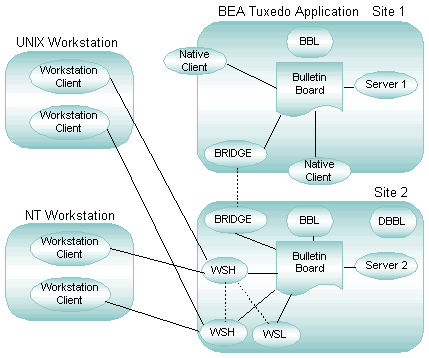


|

|
|
|
|
Sample Application with Four Workstation Clients
The following figure shows an example of an application with four Workstation clients.
Bank Application with Four Workstation Clients

Two workstation clients are running on a UNIX system; another two Workstation clients, on Windows NT. All workstation clients initially joined the application through the Workstation Listener (WSL), which delegates subsequent communication to a Workstation Handler. This process differs from the process that occurs when native clients join an application: in the latter case, the native clients attach directly to the bulletin board upon joining.
Administrative servers and application servers are located on SITE1 and SITE2. Any service request by a Workstation client to the application is sent over the network to the WSH. This process forwards the request to the appropriate server, gets a reply from the server, and sends the reply to the Workstation client.
Note: The term resource manager refers to an implementation of the XA standard interfaces that provides transaction capabilities and permanence of actions for a BEA Tuxedo application. The most common example of a resource manager is a database. A resource manager is accessed and controlled within a global transaction.
Because the application is distributed across two machines in this example, it is running in MP mode. The Workstation client sends a request to one Workstation Handler, the Workstation Handler forwards the request to a BRIDGE process, and the BRIDGE process, in turn, forwards the request to the correct machine.

|

|

|
|
|
|
Copyright © 2000 BEA Systems, Inc. All rights reserved.
|